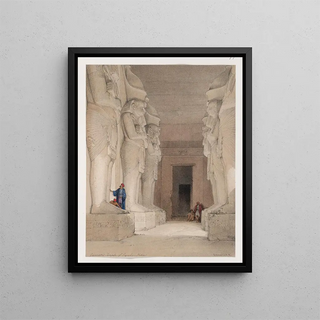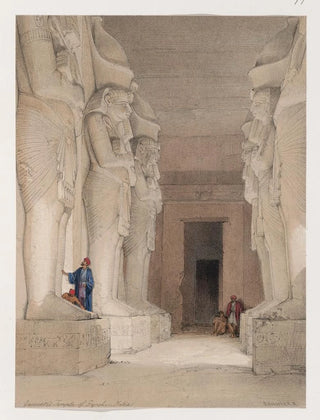Art print | Temple fouillé de Gyrshe Gerf Hussein en Nubie - David Roberts


View from behind

Frame (optional)
The "Temple fouillé de Gyrshe Gerf Hussein en Nubie" by David Roberts is a work that transports the viewer on a fascinating journey through time and space. Painted in the mid-19th century, this piece is the result of meticulous exploration of ancient ruins, revealing the grandeur of past civilizations. Roberts, as a traveling artist, captured the essence of Egyptian and Nubian landscapes, offering a romantic and almost mystical vision of these historically rich sites. The art print of this work not only allows you to admire the beauty of art but also to immerse yourself in the enchanting atmosphere of Nubia, land of pharaohs and mysteries.
Style and uniqueness of the work
Roberts' work stands out for its realistic and romantic approach, where the accuracy of architectural details blends with a light and color palette that evoke Egyptian skies. The ruined temple, depicted with remarkable precision, is surrounded by desert landscapes that seem to breathe history. Shadows and light play a crucial role in the composition, creating a striking contrast that draws the eye and invites contemplation. Roberts manages to capture the soul of this millennial edifice, evoking not only its structure but also the living history that surrounds it. Every stone, every shadow tells a story—of a time when Nubia was a crossroads of cultures and beliefs.
The artist and his influence
David Roberts, born in Scotland in 1796, dedicated much of his life to exploring Eastern lands. His travels in Egypt and the Middle East profoundly influenced his work, positioning him among the pioneers of orientalism in art. His style, both documented and poetic, inspired many artists and helped spark public interest in ancient civilizations. Through his watercolors and paintings, Roberts not only captured the beauty of landscapes but also played a key role in disseminating knowledge about Antiquity. His artistic legacy endures.

Matte finish

View from behind

Frame (optional)
The "Temple fouillé de Gyrshe Gerf Hussein en Nubie" by David Roberts is a work that transports the viewer on a fascinating journey through time and space. Painted in the mid-19th century, this piece is the result of meticulous exploration of ancient ruins, revealing the grandeur of past civilizations. Roberts, as a traveling artist, captured the essence of Egyptian and Nubian landscapes, offering a romantic and almost mystical vision of these historically rich sites. The art print of this work not only allows you to admire the beauty of art but also to immerse yourself in the enchanting atmosphere of Nubia, land of pharaohs and mysteries.
Style and uniqueness of the work
Roberts' work stands out for its realistic and romantic approach, where the accuracy of architectural details blends with a light and color palette that evoke Egyptian skies. The ruined temple, depicted with remarkable precision, is surrounded by desert landscapes that seem to breathe history. Shadows and light play a crucial role in the composition, creating a striking contrast that draws the eye and invites contemplation. Roberts manages to capture the soul of this millennial edifice, evoking not only its structure but also the living history that surrounds it. Every stone, every shadow tells a story—of a time when Nubia was a crossroads of cultures and beliefs.
The artist and his influence
David Roberts, born in Scotland in 1796, dedicated much of his life to exploring Eastern lands. His travels in Egypt and the Middle East profoundly influenced his work, positioning him among the pioneers of orientalism in art. His style, both documented and poetic, inspired many artists and helped spark public interest in ancient civilizations. Through his watercolors and paintings, Roberts not only captured the beauty of landscapes but also played a key role in disseminating knowledge about Antiquity. His artistic legacy endures.






